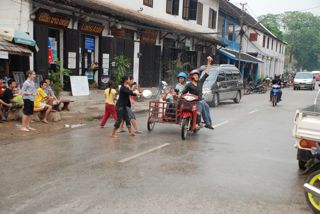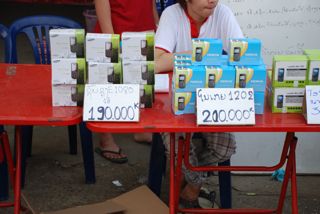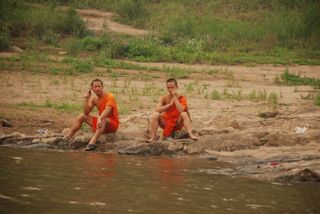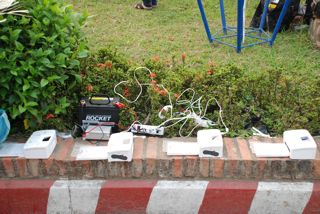
What I learned from Laos
Yawn……stretch…..nothing like a week off relaxing to get the creative juices flowing. Spring Break is now over and we’re in the home stretch here in Bangkok with 7 weeks of school to go before summer vacation starts.
Over Spring Break, my wife and I spent four days in beautiful Luang Prabang, Laos (pictures can be found here).
While in Laos, I learned a couple things that I’d like to share with you.
1. How to keep your cell phone dry during Songkran

Songkran is New Year’s in South East Asia and it typically calls for country wide water fights. No better way to celebrate New Years in 100+ degree heat than to have a huge water fight. Nobody is safe, and your cell phone is definitely not safe if kept in your pocket. But while riding a bike or motorcycle if you keep your phone high you’ll keep it dry. While riding in a Tuk Tuk, I kept my iPhone in a plastic bag…worked great!
2. Cell Phone technology is the future of wireless

So here I am in arguably one of the poorest countries in South East Asia and at the morning market, I happen upon this shop selling cell phones. The cheapest one sells for $22.45 and the most expensive one for $35.44.
The phones had the following features:
- Calls
- SMS
- MMS
- Camera
- Radio (both AM and FM)
- Weather
Cell service plans are very cheap as well. I didn’t actually price out complete plans but a SIM card to get you started with basic calls and sms sells for $5.
In many of my presentations, I talk about the future is truly in the palm of our hands. According to the International Telecommunication Union, there are 4.6 billion mobile phone subscriptions worldwide and we are on pace to pass 5 billion this year. There are just about 7 billion people on the plant. Or in other words just over 70% of the world’s population has a cell phone.
Now these phones are not iPhones, but if I was a betting man I’d say within 5 years we’d see phones at this same price that have internet capability. What happens when farmers in Laos have access to information without going to the city for internet access? Just ask Kenyan farmer Zack Matere what the cell phone and Internet access means to him.
I’m sorry to break the news to everyone….but I don’t care where you live….teaching kids today how to access information and create knowledge with it is the future. Whether you are in Kenya, Laos, or the USA.
3. The ability to connect from everywhere is the future

US Telecoms need to wake up and smell the coffee. The ability to travel anywhere and expect cheap cell phone coverage appears in most of the word except the USA (from personal experience). When a SIM card in Laos cost $5 and a SIM card in Thailand cost me $5 and a SIM card in Switzerland cost me $15. Someone please tell me why I can’t get one for less than $50 in the US? And spending less than $80 a month for service is hardly possible. I mean, when I pass a monk on a cell phone on the banks of the MeKong River and I know in the middle of seemingly nowhere he has cell service for pennies…..it’s just frustrating!
Cell coverage is the fast growing type of Internet/communication coverage world wide. Take some time to study the GSM World Coverage Map and just think about all those places that are covered…and really to cover the rest means just putting up more cell towers. As the need for the service arises putting up the tower is the easy part…and once the tower is in place upgrading the signal from tower to tower is even easier. So here in Laos now that the towers are in place, the ability to switch on 3G or heck probably 4G by the time the country is ready, is a simple upgrade of switches at hub centers.
We expect to be able to connect from everywhere. In Luang Prabang, our hotel had free WiFi and if you weren’t staying at a place that offered it, there were Internet cafes on every other corner for you to use.
What I’ve taken away from all this is as a content creator, my information better be accessible on a cell phone and I need to find a way to get our student blogs at school accessible on a cell phone as well so that they can teach students in Laos. Because those kids will all have a cell phone before they have a computer.
4. Solutions to things we didn’t know were problems

At the morning market we happened to walk by a couple people with the following set up. Before you read on take a look at this picture (click to see larger size) and see if you can figure out what this person was making money doing.
So if your guess was that this person was making $1.18 a digital picture you’re right! Yes….that is a car battery connected to a transformer that is connected to a power strip that is plugged into four little photo printers.
See here’s the thing, all these people in these rural villages now have cell phones or even a digital camera. Which is all great…but when you don’t own a computer to put those digital photos onto you have to print them. Hence a solution to a problem. The street in this particular part of the market was lined with people making money printing digital pictures. Here’s another picture of a single printer operation.
The technology had created a problem….people had pictures that they couldn’t develop, but with a little creative work technology also solved the problem. I stood and watched for a while as people stepped up paid their $1.18 and handed over their SD card to get a couple pictures printed for safe keeping.
Are we giving our students the skills to solve problems that we don’t even know are problems yet? Technology doesn’t solve all our problems and in some cases it actually creates new ones for us. Are we preparing our students to be creative and solve interesting, out of the box problems?
5. Connecting with people is what it’s all about

On our first full day in Luang Prabang, we booked a four hour trek through the Lao jungle to this amazing waterfall (yes…you could actually drive to it in about 40 minutes…but what’s the fun in that!)
When we signed up for the trip there was one other couple signed up as well. I had second thoughts about the trip because being on a trek in 100 degree heat with people that you might not get along with is just….well…let’s just say we’ve done it and it’s not a good experience.
In the end, my wife talked me into it and I’m sure glad she did. The other couple turned out to be Allie and Mark (or was it Mark and Allie…I don’t remember 😉 ) A couple from San Francisco who quit their jobs and on January 28th set off to see South East Asia.
We hit it off on the trek, chatting the whole way to the waterfalls, four hours in the jungle never seemed so short. After the hike and a dip in the water, we headed back to Luang Prabang. We ended up agreeing to meet the next night for dinner. Mark, it turns out, was one of the founders of The Flip Video Camcorder. In March of last year, Pure Digital Technologies (the company that made The Flip) was bought by Cisco Systems. Mark became the national account manager at Cisco, selling the Flip and other Cisco products.
Allie is in the tech world as well. She is a consultant for companies working on SEO (Search Engine Optimization) and helping web site content be more relevant in search results.
No wonder we got along so well. 🙂
Mark actually gave me a Flip UltraHD which is like the coolest gift I’ve ever gotten on a vacation! We also talked about their new product the SlideHD which was released just last week while we were together.
Allie and Mark few back through Bangkok on their way to Japan and we invited them to stay with us and showed them the local side of Bangkok. We ate a lot…and then ate some more!
When it’s all said and done, it is the connections with people that we take with us. Whether they are made via a cell phone call on the banks of the Mekong River, or they are a picture we want to keep to remember that moment, or just dinners and conversations with new found friends. The connections between people are what we need to remember this world is really about.








hey Jeff really nice post and I totally agree with you about connections. We have had similar experiences in terms of connecting with people in many places in Asia, north Vietnam, Thailand, China and India. it’s a blast to be in the middle of nowhere and then hit it off with other travellers. You never forget them!
Great post! Laos is an amazing place. Hoping to get to Luang Prabang this summer. Spent some time in Vien Tienne and Vang Viang last summer and LOVED it.
Connections are what is missing in so many of our relationships, lives, jobs, etc here in the STATES. If we just slowed down a bit, we might actually learn something about our colleagues and neighbors.
Kuddos to you for doing the 4 hour trek and making new connections!
I remember a talk somewhere discussing this other incredible application of cell phones in rural communities: the ability to send money to others far away. I think the idea was something like this:
* If you need money, you go to a cell phone “store”.
* You call your friend and ask them to buy air time for the store’s phone.
* The store gives you that money (minus a fee).
Elegant isn’t?! Generative systems are so fascinating in their potential to provide solutions to problems they weren’t meant solve.
[…] with growth rates like that and no sigh of it stopping I think this will even out. When I was in Laos I witnessed this first hand. In some of the rural areas we hiked through whole villiges would chip […]